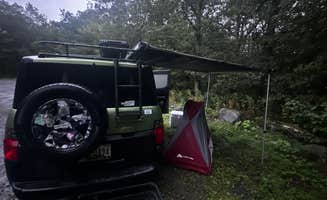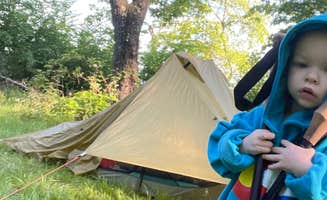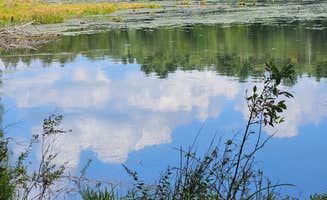Dispersed camping near Greentown, Pennsylvania centers around the Delaware State Forest which spans more than 83,000 acres of woodland terrain. The area features predominantly primitive camping options at elevations between 1,200-1,800 feet with seasonal temperature variations that can drop below freezing even in late spring and early fall. Winter conditions often make access challenging with snowfall accumulations requiring four-wheel drive vehicles on many forest roads.
What to do
Hiking accessibility: Thunder Swamp Trailhead offers extensive trail connections, as one camper noted, "Trailhead parking was chill for a night. No trouble. Tons of hiking. Went down Saw Creek trail to a marsh." This parking area serves as both an overnight option and gateway to the larger trail system.
Rocky overlooks: Bake Oven Knob provides exceptional ridge views along the Appalachian Mountains. "The hike to the overlook is really lovely; short and rocky," reports one visitor who regularly uses the area as both a day hiking destination and overnight spot.
Water activities: Fishing and non-motorized boating opportunities exist at select ponds throughout the region, though water access varies seasonally. Most small lakes and ponds require carrying in watercraft as improved boat launches are limited.
What campers like
Hammock camping opportunities: Appalachian Trail- Designated Backpacker Campsite 2 receives positive feedback for hammock setup options. One camper shares, "We camped nearer to others but there are secluded spots too. We'll maintained w bear boxes provided. Good trees for hammocking."
Lakeside settings: Hickok Brook offers waterfront camping in a remote setting. A visitor describes it as a "Really nice quiet place" despite limited camping spaces, noting there are "only 3 spots" in the immediate area.
Solitude factor: Most dispersed sites near Greentown feature relatively low usage compared to developed campgrounds. Thunder Swamp Trailhead provides reliable overnight parking where "No one bothered me" according to one camper who appreciated the "Plenty of shade" in the gravel lot.
What you should know
Access road conditions: Reaching many dispersed sites requires navigating unmaintained forest roads. At Hickok Brook, a camper warns, "I drove in thinking that there would be flat places to park a very rugged camper in my full ton diesel pickup. The road is very rough with huge potholes so good clearance is a must."
Site identification challenges: Many camping areas have minimal or no signage. At Appalachian Trail campsites, "The site itself is unmarked when you come to it, but it's the only pretty obvious camping spot on the trail so it's not hard to find."
Limited facilities: Most dispersed camping areas around Greentown have no water sources, restrooms, or trash collection. Bake Oven Knob provides parking but no amenities, requiring complete self-sufficiency for overnight stays.
Tips for camping with families
Site security considerations: Appalachian Trail Campsite locations typically offer more established spaces for families with children compared to undefined dispersed areas. Many AT sites include bear boxes for food storage.
Water planning essential: No reliable water sources exist at most sites, requiring families to carry all drinking water. Carrying 1-2 gallons per person per day is recommended, particularly during summer months.
Weather preparedness: The Pocono elevation means significant temperature drops at night even during summer months. Nighttime temperatures can fall 20+ degrees below daytime highs.
Tips from RVers
Limited parking dimensions: Thunder Swamp Trailhead accommodates smaller vehicles but space restrictions apply. One camper describes it as "a gravel parking lot" suitable for overnight stays in modest-sized vehicles.
Alternative considerations: Most dispersed camping areas near Greentown have severe limitations for larger vehicles. A visitor to Hickok Brook stated it's "not a good spot for car camping but you could conceivably drive up to the spots and pull off the road to put up a small tent somewhere. Very gorgeous but not rv friendly."
Seasonal access variations: Forest roads frequently become impassable for larger vehicles during spring thaw or following heavy rain. Four-wheel drive or high-clearance vehicles are typically required year-round.




